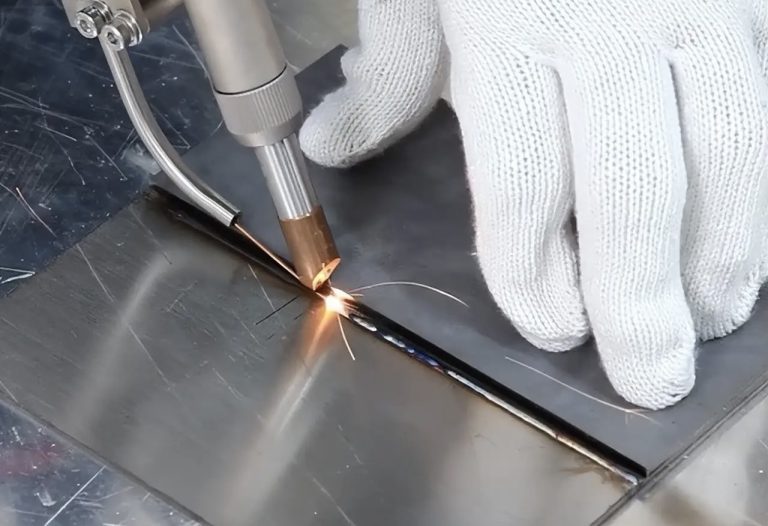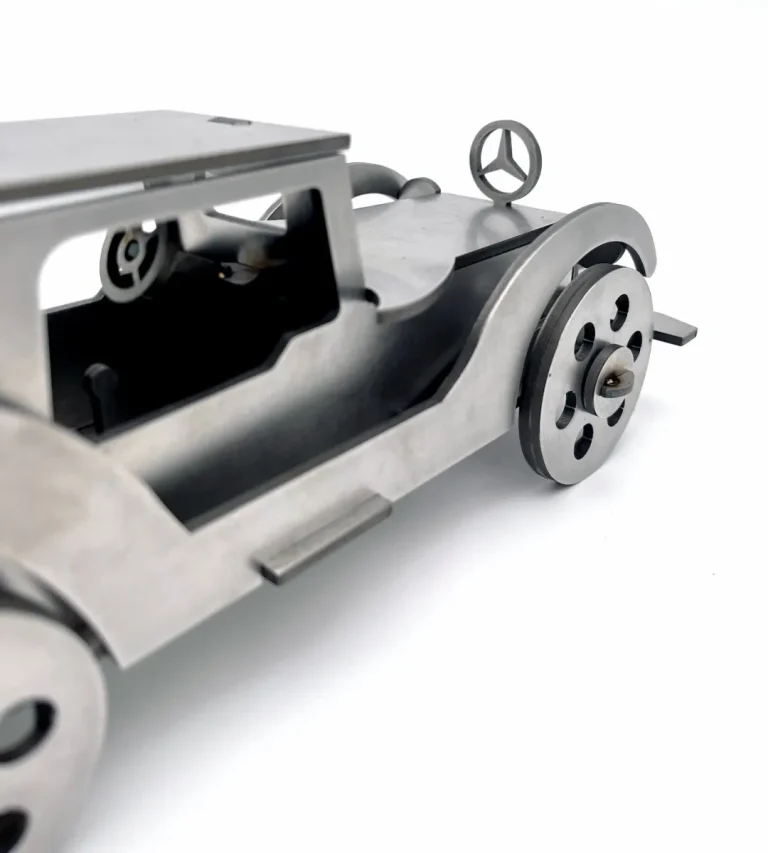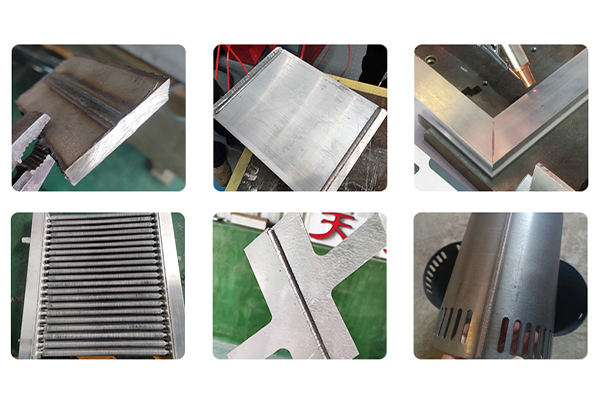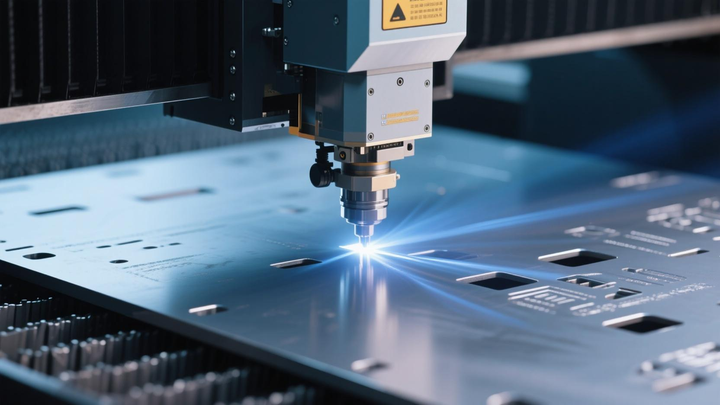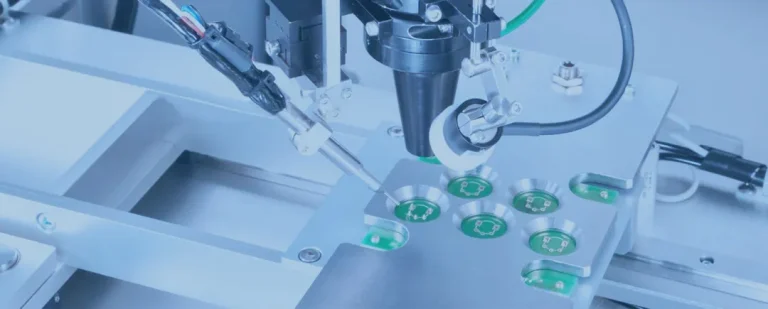Laser welding technology is characterized by high process efficiency and flexibility. In the process of automobile manufacturing, it can be used to weld the body and various automobile parts, reduce the overall weight of the body, improve the precision of body assembly, and meet the needs of automobile manufacturing lightweight and enhanced safety performance.
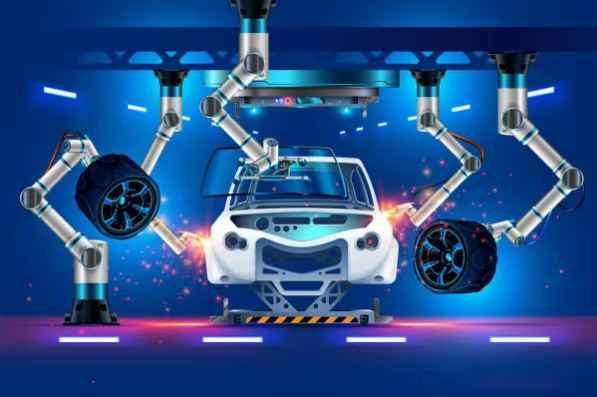
It also helps to reduce assembly and stamping costs in automobile manufacturing, thus improving body integration.
Therefore, how to actively and effectively apply laser welding technology has become a current consideration for automobile manufacturers. In this paper, the application of laser welding technology will be discussed in detail.
1.Overview of laser welding technology
(1)Principles of Laser Welding Technology
Laser welding is essentially a fusion welding technology that uses a laser beam as the main energy source. The welding of the workpiece is accomplished by a certain impact force.
Laser beam generation is realized by optical oscillator. When the high power laser beam acts on the metal surface, it can vaporize the metal rapidly. When the melted metal liquid surrounds the vaporized holes, a weld is formed under the action of stress as well as under the heating and cooling methods to finally complete the welding of the metal.
It should be noted that laser beams of different powers have different densities, which affects the depth of the weld. As the density of the laser beam increases, the depth of melting increases, resulting in a deeper weld. Conversely, it decreases the depth of melting, making it shallower.
(2)Advantages and Disadvantages of Laser Welding Technology
The advantages of laser welding technology play a significant role in current automobile manufacturing, which are mainly reflected in the following aspects: the actual welding is subjected to a small range of heat influence, and the deformation is lower. Welding quality and precision are relatively high, in order to ensure the quality of the same time to ensure that the aesthetic.
Specific welding operation is flexible and efficient, which can meet the needs of enterprises. The construction noise is low, and the energy-saving effect is remarkable. Suitable for welding brittle, high strength and high melting point materials. For detailed information, please refer to Table 1.
Table 1: Score Comparison of Different Welding Technologies
| Comparison Items | Laser Welding | Electron Beam Welding | Tungsten Inert Gas Welding | Resistance Welding |
|---|---|---|---|---|
| Welding Efficiency | 6 | 7 | 4 | 8 |
| Large Depth Ratio | 9 | 8 | 3 | 4 |
| Weld Cross – Section Morphology | 8 | 8 | 5 | 5 |
| Welding at Atmospheric Pressure | 9 | 3 | 7 | 9 |
| Welding of High – Reflectivity Materials | 4 | 8 | 7 | 8 |
| Cost | 4 | 3 | 8 | 8 |
| Operating Cost | 6 | 6 | 7 | 9 |
| Reliability | 8 | 4 | 8 | 9 |
| High Welding Speed | 9 | 9 | 8 | 3 |
However, laser welding technology also has certain disadvantages, specifically: high requirements for welding position, focusing on the range of welding requirements. Not suitable for materials with large thickness.
When welding materials with high thermal conductivity, it will affect the welding effect. Low energy conversion efficiency, weld solidification time is too fast, to a certain extent, restricting the welding effect.
2.Practical applications of laser welding technology
(1)Laser Conduction Welding
In the field of laser welding technology, laser conduction welding is a process in which two or more parts are melted and cooled to fuse into a unified whole for effective welding. This method does not require the addition of flux and has the advantage of saving costs.
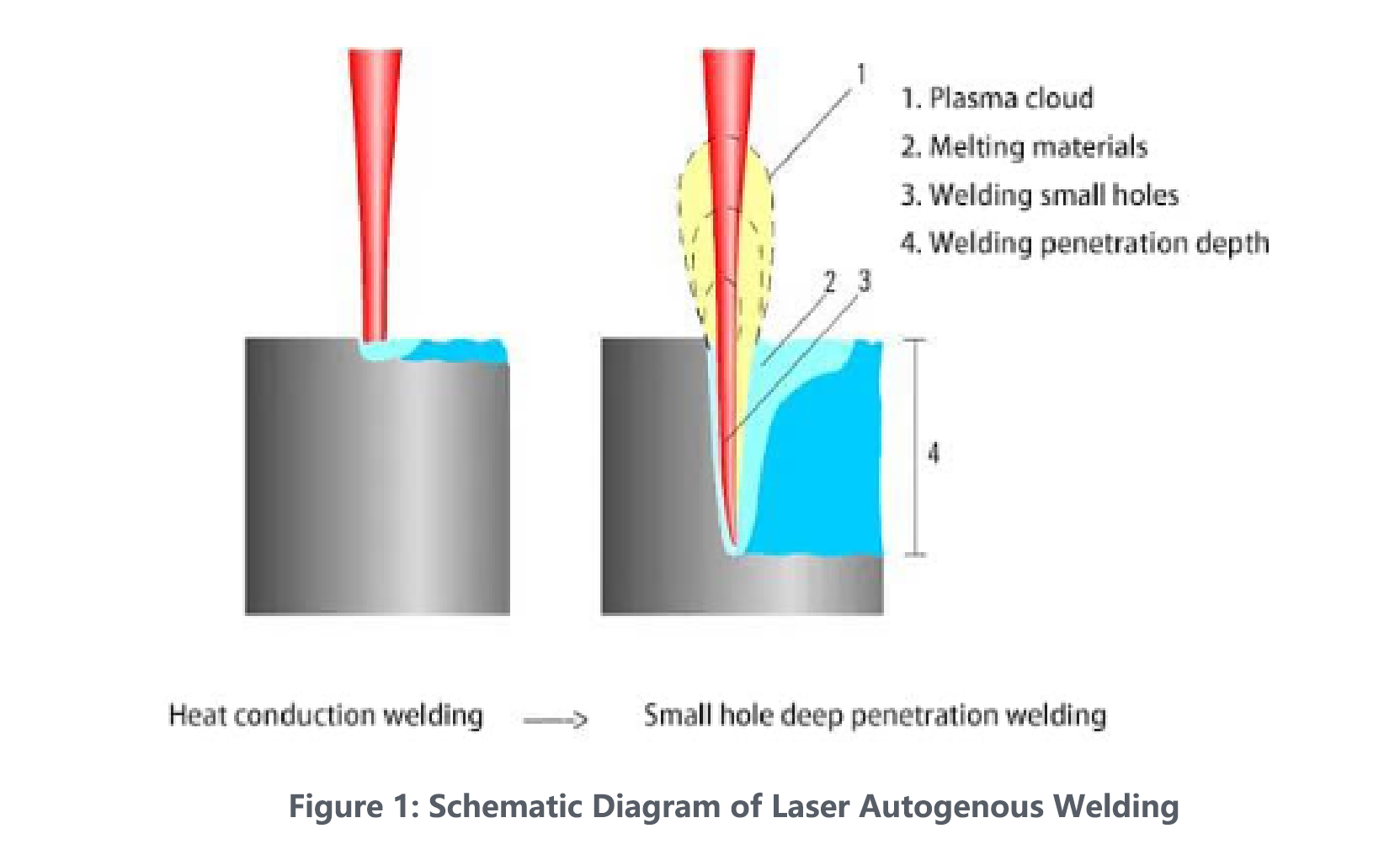
During the operation, under the action of the laser beam, the surface temperature of the parts to be welded rapidly reaches the boiling point, causing the metal to vaporize and form a cavity, as shown in Figure 1.
The cavity stops deepening once the recoil pressure of the metal vapor balances with the surface tension of the liquid metal and gravity. When the cavity at a stable depth closes, the weld is complete, marking the completion of deep melting laser welding.
At present, in automobile manufacturing, laser conduction welding is widely used in body assembly, grouping, parts welding and so on. For example, this welding method is used for welding the side circumference of Volkswagen Passat, Touguan, Jetta and other models. Similarly, the doors of certain Peugeot and Citroen models are also welded using laser conduction welding.
In addition, there are various classifications based on the type of weld, including single straight seam, multiple welds and non-linear welds. Due to the simplicity of producing a single weld seam, it has been widely adopted.
Volkswagen of Germany pioneered the application of laser overlay welding on the chassis of Audi models in 1985, followed by Toyota of Japan, which adopted wire-fed laser welding on the body side frames in 1986.
Laser stack welding technology in North America’s volume applications began in 1993, when the United States aims to enhance the competitiveness of American cars against Japanese cars through the 2mm program.
At present, almost all the world’s leading automobile manufacturers have widely adopted laser stack welding technology, covering side frames, inner door panels, windshield frames, wheel covers, floors, center pillars and other structural parts.
The United States was one of the first countries to introduce high-powered lasers to the automotive industry, and the Detroit area is home to dozens of laser-processing stations that specialize in cutting automotive metal parts and welding gears. This advancement has reduced the time it takes to redesign a car from five years to two.
General Motors has implemented more than two dozen laser processing lines, and Ford Motor Company uses Nd:YAG lasers in conjunction with industrial robots to weld car bodies, dramatically reducing manufacturing costs.
By 2000, 50% of the resistance spot welding production lines of the three major U.S. automobile companies were replaced by laser welding lines.
In Japan, the successful application of laser welding on production lines has attracted worldwide attention. For example, the innovative method of laser welding thin steel plates before they are press molded into automotive body parts has now been emulated by the majority of the world’s automobile manufacturers.
Many well-known car manufacturers have set up specialized laser welding lines: Thyssen’s welding line for automotive underbody assembly, Volkswagen’s laser processing line for gears, and Mercedes-Benz’s installation of laser processing equipment in eight of its 18 plants.
(2)Laser Fillet Welding
In laser welding technology, laser fillet welding is based on the principle of adding a specific welding material to the weld seam. The laser beam melts the added welding material to form a welded joint.
Laser fillet welding has significant advantages over conventional non-fillet welding methods. It not only expands the range of applications for laser welding, but also enables thick plates to be welded with lower power and higher weld quality.
It should be noted that in laser fillet welding, both the wire and the base material must be melted. This creates small holes in the base material, allowing the wire and base material to completely fuse and form a new hybrid melt pool.
This hybrid pool is significantly different from the wire and base material and has the potential to improve some of the performance disadvantages of the base material. The use of suitable composition of the wire as filler material, can ensure that the weld has a high wear resistance and corrosion resistance.
(3) Laser-Arc Composite Welding
In laser welding, the principle of laser-arc composite welding is to combine a laser heat source with an electric arc to act on a single molten pool, thus realizing welding. As shown in Figure 2, this welding method is characterized by small deformation, high speed and high adaptability.
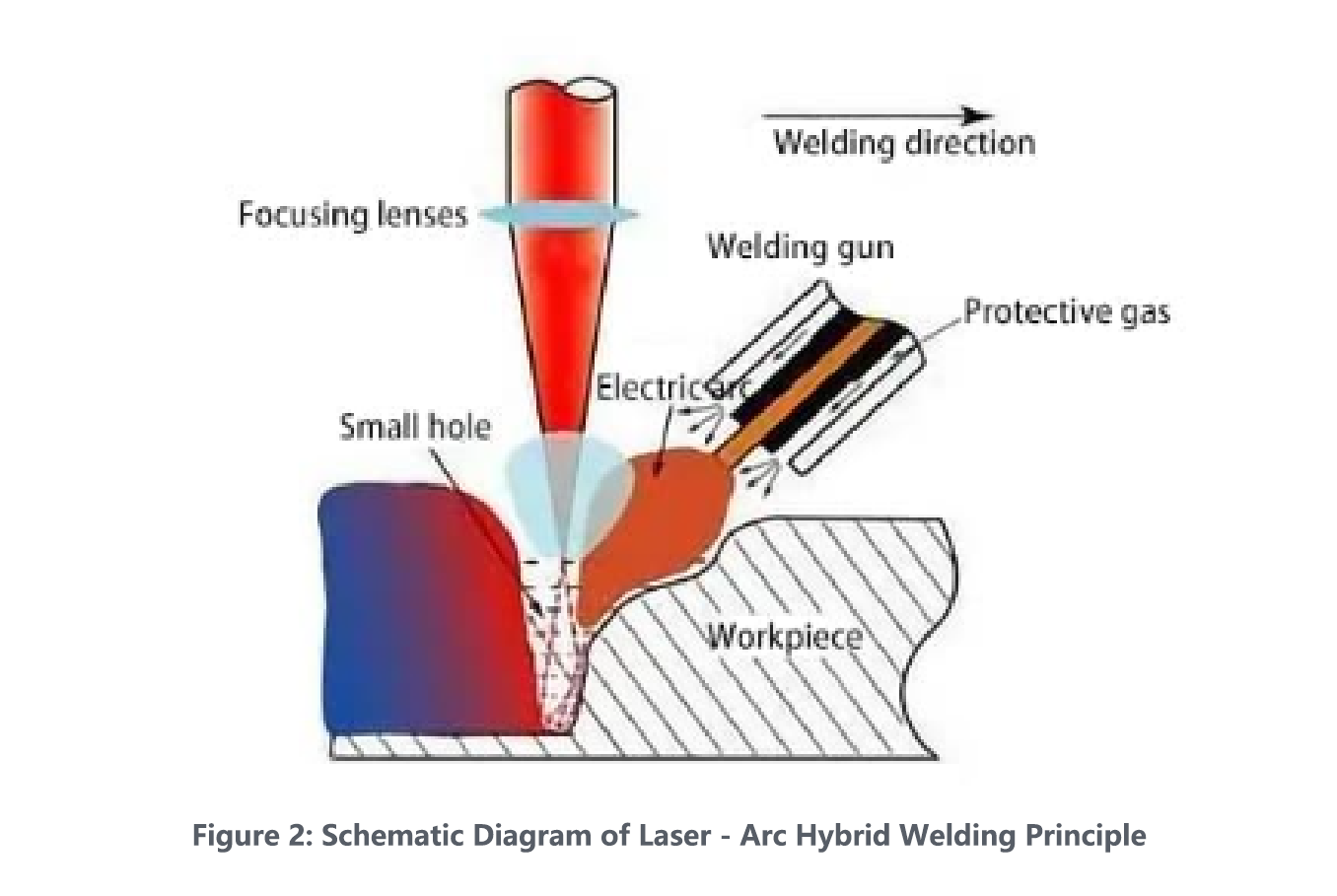
Laser-arc composite welding is used for the welding of the most critical all-aluminum body in the production of Audi AG series cars in Germany. The body belongs to the second generation of the luxury Audi A8 series and was designed with a focus on crash safety and resistance to torsional deformation. The weld produced by laser-arc composite welding meets all the requirements and is characterized by toughness, high strength and deep fusion.
In order to meet the high expectations of customers for this vehicle, every detail has been carefully crafted to ensure build quality. The narrow weld seams of laser composite welding meet the high appearance standards required for the workpiece, eliminating the need for plastic strips to fill in the corners of the top of the body frame.
In the manufacture of lightweight vehicles, in addition to meeting all of the above requirements, there are also special conditions that must be met, and the production process for all-aluminum bodies has even stricter requirements.
(4) Laser Remote Welding
In laser welding technology, laser remote welding can be processed at a distance with the help of a high-speed scanning vibration lens, and parts are welded with laser beams of different powers.
Due to its unique technical advantages, it is widely used in the panoramic sunroof of Mercedes-Benz and the side welding of Volkswagen and Audi cars. At present, the application of laser remote welding in automobile manufacturing has the following advantages:
①High positioning accuracy, which can realize rapid welding and meet the manufacturing needs of automotive companies.
②The ability to combine different structural strengths for welding to meet the needs of various weld shapes.
Laser remote welding requires high quality materials and equipment. For thicker parts, it is not possible to reduce the depth of the weld, resulting in lower shear strength at the weld.
(5) Laser brazing
Among the laser welding techniques, laser brazing has the advantages of good appearance and sealing as well as high weld strength. The basic principle is to focus a laser beam onto the surface of the filler wire, melt it, and then fill it into the weld area to complete the brazing process.
Although similar to fusion welding, the base material does not melt in this method. Therefore, the melting point of the brazing material must be lower than that of the base material in order to be able to effectively weld through the liquid brazing material, as shown in Figure 3.
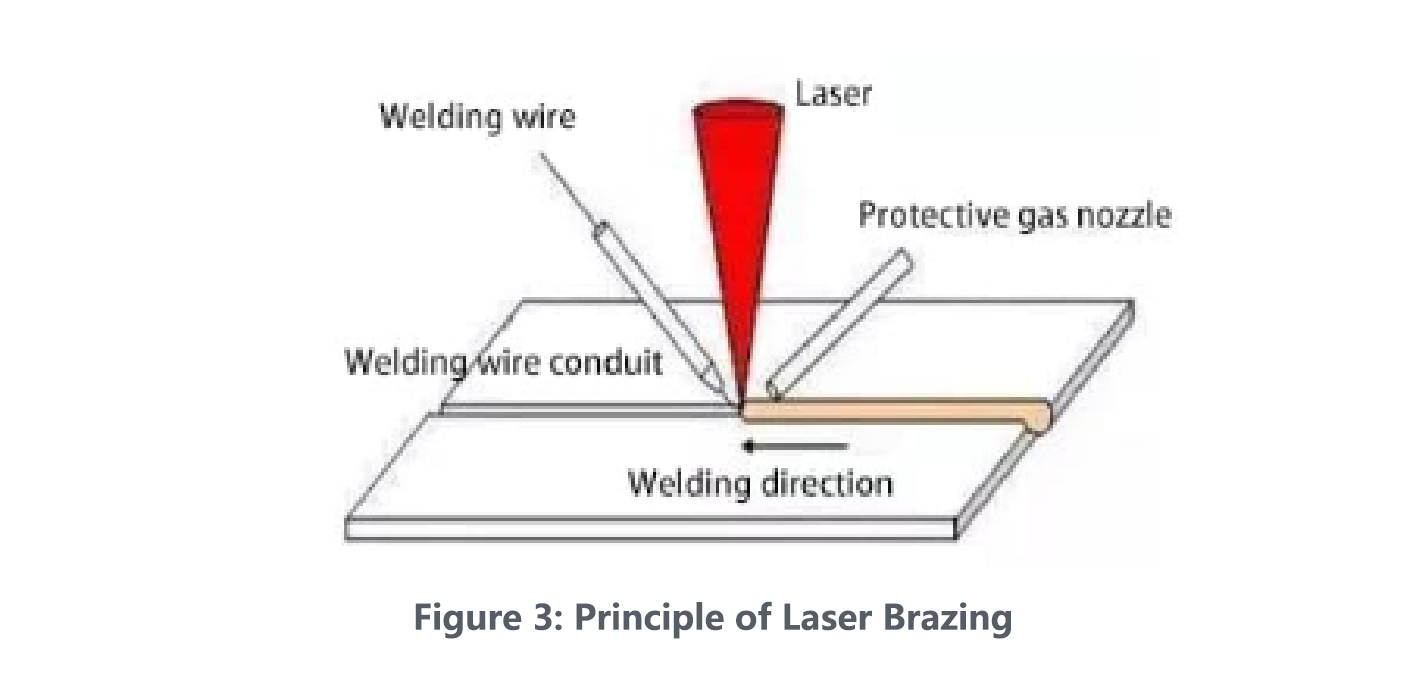
Laser brazing is currently used to weld the trunk lid of Volkswagen, Haima, Chery and Audi. It is also frequently used for roof and sidestand connections on Cadillac, Porsche, Ford, Volkswagen and other brands.
When using this technology, it is vital to consider the effects of various factors on the welding process, especially process parameters such as welding speed, laser power and beam diameter. These parameters must be adapted and designed to the specific welding requirements to ensure the effectiveness of laser brazing.
Laser brazing equipment typically incorporates a brazing processing lens into the robotic arm. The laser beam is focused on the joints of the plates and melts a filler wire (e.g. copper-silicon wire) to join the parts. The success of this method lies in the fact that joint strengths approaching weld strength are achieved, and the welds are known for their aesthetic appeal.
Welds produced by laser brazing are known for their high sealing performance and smooth, clean appearance, requiring little rework. For example, the bodywork can be painted directly after cleaning.
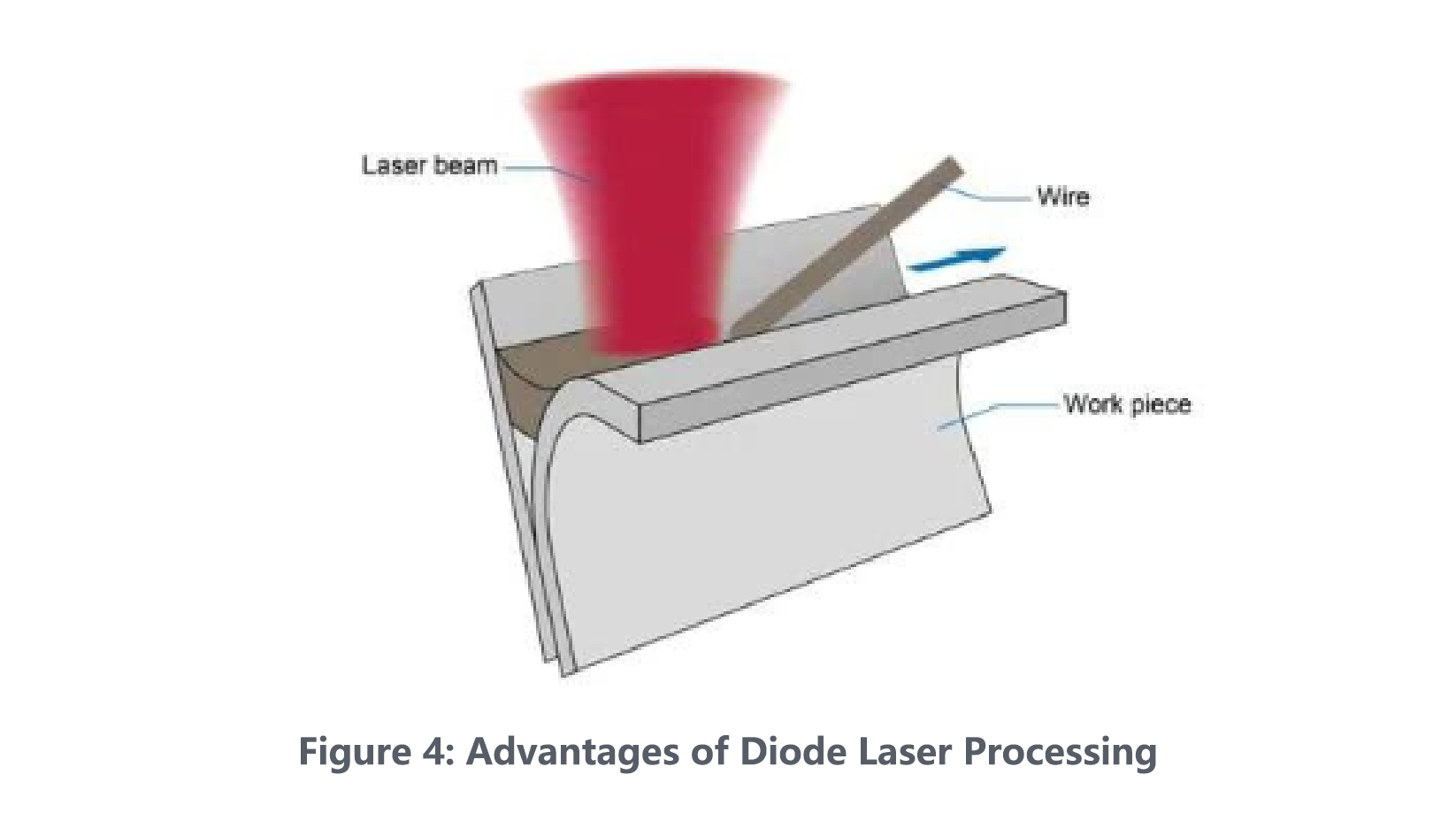
Laserline diode lasers are highly regarded worldwide for their utility in laser brazing. More than 800 LDF diode lasers have been successfully deployed for long-term use in automotive body assembly applications worldwide. High-quality laser brazing requires not only high weld strength and minimal heat impact, but also an aesthetically pleasing welded joint.
A significant processing advantage of semiconductor lasers is the stability of the molten pool they produce. In addition, the three-beam module developed by Laserline shows even greater advantages in brazing applications, ensuring high-quality welded connections without compromising on welding speed, even when welding challenging materials such as hot-dipped galvanized steel.
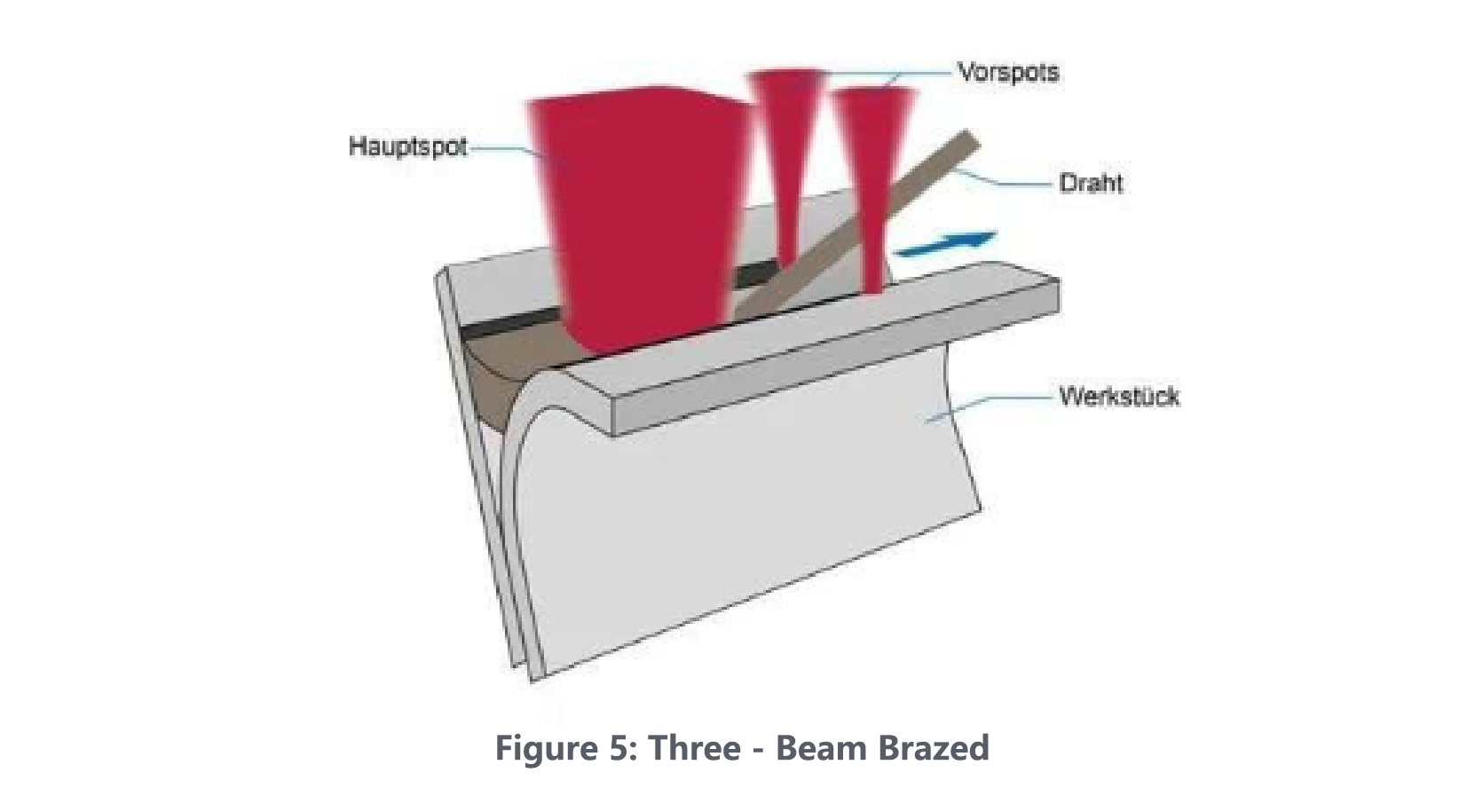
Laser brazing has become a mainstream processing method in automotive body production.
However, the increased use of galvanized steel materials poses a number of challenges, such as increased particle spatter during brazing and increased corrugation at the welded joints, and processing speeds need to be reduced to avoid these problems.
Laserline developed a breakthrough solution: using a multi-beam module with the side beams positioned in front of the main beam, the galvanized layer around the weld seam is removed first, thus ensuring that the brazing process runs smoothly without reducing the brazing speed. This technology has been well received by the industry.
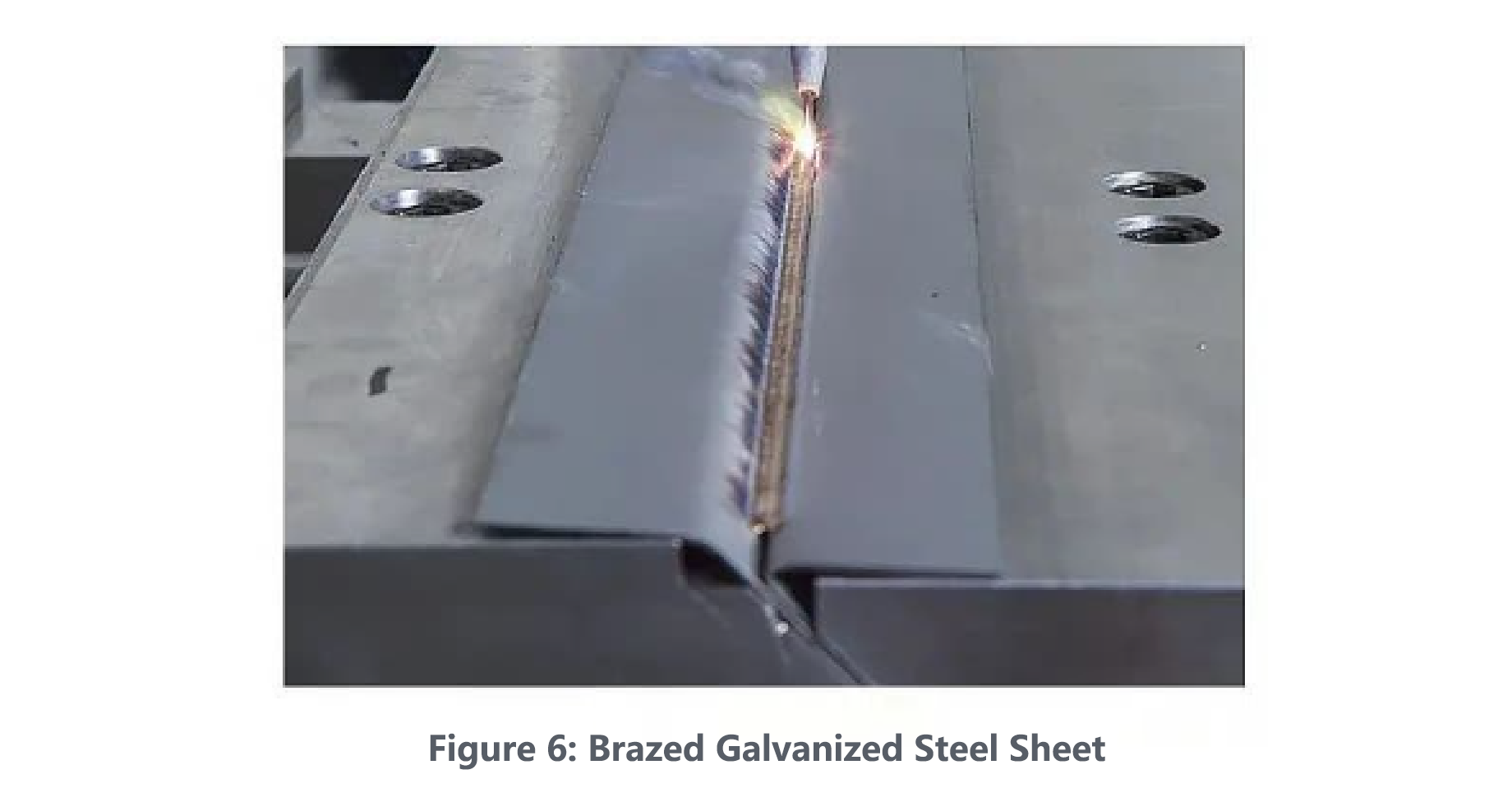
Conventional diode laser brazing of galvanized steel is performed in single-beam technology with the laser source integrated into the brazing robot. Due to the stability of the molten pool produced by the diode laser, laser cladding of silver or brass as base material is possible.
The weld seams are aesthetically pleasing and of high quality. The Volkswagen Touareg was subjected to brazing experiments in Wolfsburg, Germany, comparing a 4kW YAG laser with a 6kW diode laser. the operational stability of the LDF diode laser was confirmed in series production.
CONCLUSION
For the automobile manufacturing industry, different laser welding technologies have different utilization values.
Choosing the appropriate welding method for different parts of the automobile can improve the overall quality of automobile manufacturing and meet the needs of automobile enterprises in terms of welding cost and efficiency.
This paper analyzes the principle, advantages and disadvantages of laser welding technology, and discusses the application effect of laser self-melting welding, laser filler welding, laser arc composite welding, laser remote welding, and laser brazing in automotive manufacturing.
It provides welding experience for the automotive industry and aims to improve the welding level of automotive enterprises and promote the healthy and sustainable development of the automotive manufacturing industry.

